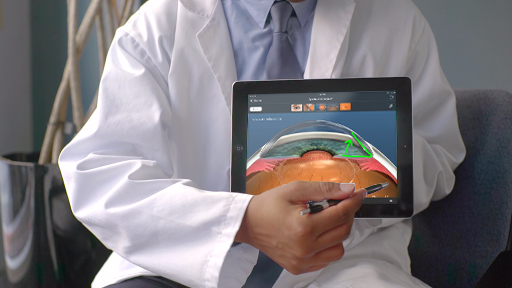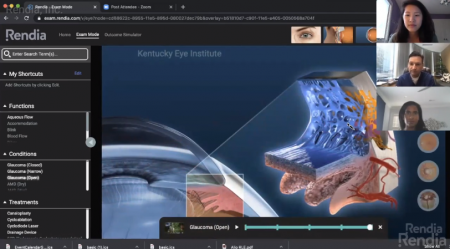Digital patient engagement tools are here to stay
Health care will never be the same. With less time spent in person with patients to limit the spread of COVID-19, doctors have had to adapt how they deliver care, both in their offices and online. If we’re being honest, some of the changes were long overdue.
And some doctors were already ahead of the game when the pandemic hit—especially those who had already adopted digital patient education and other patient engagement technologies. If you haven’t done so yet or want to take it further, it’s not too late. Here’s how Rendia’s interactive anatomy tool Exam Mode can benefit your practice, now and going forward.
Interactive visuals that educate patients on anatomy and conditions
There’s a reason people go to YouTube to learn how to change a tire or knit a scarf. It’s difficult to communicate the details effectively without pictures, and difficult for patients to understand health concepts without them, as well. Visual aids like wall charts or diagrams sketched on a prescription pad help a little, but these options are limited, too.
What you really need is a detailed, interactive, 3D view that shows the anatomy realistically and lets patients visualize disease progression or the benefits of various treatment options. That’s exactly what Exam Mode does.
Exam Mode shows an interactive, 3D view of the anatomy that lets patients visualize disease progression and the benefits of various treatment options.
In Exam Mode, choose from an extensive menu of conditions in the sidebar, from blepharitis to vitreous detachment. This allows you to show patients what happens in the eye with a particular condition or how it progresses over time. The treatment options menu lets you animate a BlephEx treatment, for instance, or show patients what happens during a MIGS procedure.

Doctors who use Exam Mode say “It is a game changer in real-time patient education.” Joseph Deering, O.D., says he and his patients both love Exam Mode. “Being able to quickly give them a tour of an eye to clear up some simple misconceptions leaps the conversation forward and personalizes their eye experience whether they are completely healthy, have advanced disease, are 5 or are 100.”
One of the best parts about using Exam Mode in our current health care environment is that it can be used just as easily and effectively during virtual visits as it can in-person. During a telehealth consultation, simply share your screen and show patients a condition or treatment in Exam Mode, just as you would on an iPad if they were in the exam room with you.

Saves time explaining conditions, for both in-person and virtual visits
A common approach practices are taking now is moving everything possible online in order to minimize COVID-19 exposure and risk for doctors and patients while maximizing the value of in-person interactions. That could mean an entirely virtual visit, but many practices are embracing a hybrid appointment model that puts more emphasis on educating patients before and after the appointment to save time in the exam room.
By saving time and sharing screens, Exam Mode addresses two of doctors’ biggest issues during COVID-19: proximity to patients and time with patients.
During the appointment, whether in-person or virtual, Exam Mode can save time spent explaining common conditions you treat every day, and also help you effectively explain rare or complex cases that cause bottlenecks in your appointment schedule. Visuals help patients understand better in less time.
Paul Karpecki, O.D., said, to limit exposure during COVID-19, “the two big issues are proximity to the patient and time with the patient. And Exam Mode saves 5 to 10 minutes. Because it’s on the screen in my lane, I can easily be 3 to 4 feet from the patient and still be connected with them, and we’re both looking at the screen.”
Shaving 10 minutes off each patient visit over the course of a day adds up to substantial time savings. And if you’re also improving communication and patient understanding? That’s a win-win.
How Exam Mode helps increase adherence
COVID-19 is increasing the prevalence of certain conditions such as myopia and dry eye. But eye doctors are also seeing an increase in symptoms in patients who have already been diagnosed and are on a treatment plan. What’s the problem? Adherence.
During telemedicine visits, Cynthia Matossian, M.D., became aware that many of her patients were not keeping up with their treatment regimens, she wrote in the Ophthalmology Times. For some, this was because they didn’t understand the reasons behind what was prescribed, such as the patient who mistakenly thought that one thermal pulsation treatment would fix her problems forever because her glands had been “cleaned out” now. Dr. Matossian wrote, “We talked about how she sees her dental hygienist twice a year, and that, in a similar fashion, we have to continue to maintain lid and meibomian gland health over time.” Exam Mode’s animations can help patients grasp these concepts.
Using visuals helps patients understand the reasons for prescribed treatments more effectively than verbal communication alone.
Dr. Matossian also discovered that some patients’ nonadherence was due to disruptions to their routines—they were taking their omega-3 fatty acid supplements erratically or using their eye drops on an as-needed basis rather than twice daily as prescribed.
“People only absorb a fraction of what we say during an in-person office exam” or telemedicine visit, “so I’m realizing that we need to give instructions in many different formats … and underscore key messages more often,” wrote Dr. Matossian.
Send patients this video before the appointment, then use Exam Mode during your virtual exam to help them understand the meibomian glands. Send them this video afterwards to encourage adherence, and this video to touch base with patients you haven’t seen in awhile, who may not realize their symptoms are related to dry eye.
Learn how Dr. Paul Karpecki uses Exam Mode to explain glaucoma and MIGS to patients with glaucoma and cataracts. Watch his 4-minute tutorial here.

